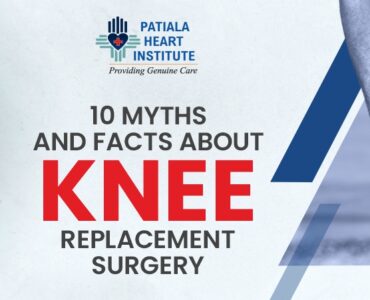Knee replacement is a common but life-changing procedure that alleviates pain and restores mobility in individuals suffering from severe knee damage due to knee injury, arthritis, or other conditions. The procedure has witnessed remarkable advancements over the years. Among these advancements, robotic knee replacement surgery has gained significant attention.
Robotic knee replacement surgery uses computer-assisted technology to guide the surgeon during the procedure, unlike traditional knee replacement surgery, where orthopaedic surgeons perform the procedure manually.
In this blog, we will compare and contrast these two approaches to comprehensively understand their advantages and differences, helping you make an informed decision about your healthcare.
What is Knee Replacement Surgery?
The knee, a complex joint central to our ability to sit, stand, walk, run, and perform daily activities, is susceptible to wear and tear over time. Factors such as injury, ageing, and medical conditions like arthritis, can lead to knee joint deterioration, causing pain, inflammation, and limited range of motion.
To treat knee joint problems and restore mobility, knee replacement surgery can be a viable solution, especially when other treatment options like medication and physical therapy fail to provide relief.
The traditional knee replacement procedure involves the removal of damaged bone and cartilage and replacing it with an artificial joint made of plastic, ceramic, and metal.
Traditional Knee Replacement
Traditional knee replacement surgery is an orthopaedic procedure that has been a preferred choice of treatment for many years. The knee joint’s damaged portion is removed and replaced with an artificial joint during the surgery.
The procedure involves making a long incision in the middle of the knee joint to access and view the affected area. The orthopaedic surgeon then removes the damaged bone and cartilage from the femur, tibia, and patella, shapes the remaining bone to accommodate the artificial implant, and secures the implant in place.
In traditional knee replacement surgery, the surgeon relies on X-ray imaging for visual evaluation and surgery.
Robotic Knee Replacement Surgery
Robotic knee replacement surgery represents a leap forward in precision and customization. The key differentiator is the integration of robotic technology into the surgical process. Before the surgery, advanced imaging technology generates a 3D model of the patient’s knee, allowing the surgeon to plan the procedure with exceptional accuracy.
During surgery, the robotic system acts as a guide, assisting the surgeon in executing the pre-planned procedure with remarkable precision. This technology allows for real-time adjustments, ensuring optimal placement of the artificial joint components.
Difference between Traditional and Robotic Knee Surgery
To understand the difference between the two approaches, let’s compare the key aspects of the procedure:
Surgical Technique
In a traditional knee replacement, surgeons use X-Ray imaging for visual evaluation and manual techniques to remove the damaged portion of the bone and cartilage.
Whereas robotic knee replacement surgery integrates advanced technology to guide the surgeon. 3D imaging and real-time adjustments enable precise implant placement. Surgeons also use robotic assistance to prepare the bone surface and place the artificial joint components.
Incision
The traditional knee replacement procedure involves making a long incision of about 10-12 inches long using conventional surgical tools, leading to more tissue disruption and longer recovery.
Robotic surgery often uses smaller incisions, resulting in lesser tissue trauma, reduced scarring, and quicker healing.
Precision and Accuracy
The precision of traditional knee surgery largely depends on the surgeon’s skill and experience. While experienced surgeons can achieve accurate results, there is potential for slight variations in outcomes.
On the other hand, robotic knee replacement surgery provides a higher level of precision due to its ability to follow pre-programmed plans and make real-time adjustments. This can result in more consistent and accurate implant positioning.
Recovery Time
Recovery time after traditional knee replacement surgery can be longer due to larger incisions and greater tissue trauma during the procedure. Patients may experience a slower return to normal activities.
Robotic-assisted surgery’s smaller incision and minimised tissue trauma can lead to a faster recovery. Patients often experience less pain, reduced inflammation, and quicker rehabilitation.
Personalization
While traditional surgery is effective, it follows a standardised approach that might not account for variations as per individual’s needs.
Robotic surgery’s 3D imaging allows for precise customization of the surgical plan to match the patient’s unique joint structure, leading to a more personalised outcome.
Surgeon’s Experience
In traditional surgery, the outcome can be influenced by the surgeon’s skill, experience, and judgment can influence the outcome.
Robotic systems provide an additional layer of support, assisting surgeons in performing the procedure with a higher level of accuracy, which can help even less experienced surgeons achieve optimal outcomes.
Patient Outcome
Traditional knee surgery can yield positive outcomes, relieving pain and improving joint function. Results may vary based on the surgeon’s skill and the patient’s unique circumstances.
Robotic-assisted surgery’s enhanced accuracy can improve joint function, reduce pain, and potentially improve long-term outcomes.
Advantages of Robotic Knee Replacement Surgery
Robot-assisted knee replacement surgery offers several advantages over the traditional approach:
Improved accuracy: Robotic systems enhance surgical precision, leading to more consistent outcomes and reducing the need for revision surgeries.
Minimal invasion: Robot-assisted knee replacement surgery involves smaller incisions, providing a quicker recovery time.
Personalised Implant Placement: The 3D modelling and real-time adjustments enable personalised implant placement, leading to better joint function and longevity.
Reduced Damage to Surrounding Tissues: Robotic systems can minimise damage to surrounding muscles and ligaments, contributing to a faster and less painful recovery.
Potential for Quicker Recovery: With reduced tissue trauma, smaller incision, and optimised implant placement, patients may experience a shorter hospital stay, speedier recovery, and lesser levels of discomfort.
Factors Influencing Patient’s Choice of Surgical Approach
When facing the decision to undergo knee replacement surgery, patients may have to choose between traditional or robot-assisted procedures. The decision can significantly impact the surgical outcome, recovery process, and overall quality of life post-surgery.
Understanding the factors that influence patients’ choice of surgical method is crucial for making an informed decision that aligns with individual needs and preferences.
The severity of knee damage: The extent of knee joint deterioration plays a significant role in determining the most suitable surgical approach. Patients with severe joint damage might benefit from the precision of robotic-assisted surgery, which can optimise implant placement and potentially lead to better long-term outcomes. However, patients with less severe damage might find traditional surgery equally effective in providing relief and restoring mobility.
Recovery Time and Post-Surgery Experience: The recovery period following knee replacement surgery is a significant consideration for patients. Robotic-assisted procedures may lead to a quicker recovery and shorter hospital stays. Patients prioritising a faster return to their daily activities may choose a robotic approach.
Surgeon Recommendation and Expertise: As experts in the field, orthopaedic surgeons play a vital role in guiding patients toward the most suitable surgical method. Their recommendation, based on an evaluation of the patient’s medical history, joint condition, and individual preferences, can heavily influence the decision-making process.
Requirement for personalised treatment: Robotic-assisted knee replacement surgery stands out for its ability to offer personalised treatment plans. Through advanced imaging and 3D modelling, surgeons can tailor the procedure to the patient’s unique anatomy. This level of customization can benefit individuals who require a surgical approach that is finely tuned to their specific joint structure and needs.
The world of knee replacement surgery has witnessed remarkable advancements, from traditional methods to the integration of cutting-edge robotic technology. While both approaches offer reliable outcomes, robotic-assisted knee replacement holds the promise of enhanced precision, personalization, and potentially faster recovery.
Get freedom from knee pain at Patiala Heart Institute, your premier destination for top-notch healthcare. Our renowned orthopaedic surgeons specialise in robotic knee replacement surgeries, offering you the best care available.
Experience the expertise of the best knee replacement surgeon in Patiala and explore the advantages of full knee replacement in Patiala with our advanced robotic technology. Schedule a consultation today at Patiala Heart Institute and take the first step towards a pain-free tomorrow with our expert orthopaedic surgeons.
What Is The Typical Duration Of A Robotic Knee Replacement Procedure?
The duration of a robotic knee replacement procedure can vary based on factors such as the complexity of the case, the patient's anatomy, and the surgeon's experience. On average, a robotic knee replacement surgery may take about an hour. Your orthopaedic surgeon will provide you with a more accurate estimation based on your individual case.
Are There Any Specific Age Limitations For Undergoing Robotic Knee Replacement Surgery?
Age is not the sole determining factor for undergoing robotic knee replacement surgery. The decision to undergo surgery is based on the patient's overall health, lifestyle, degree of knee damage, and the impact of knee pain on daily activities. Moreover, robotic knee replacement can benefit patients of all age groups. Your orthopaedic surgeon will evaluate your medical history and perform a thorough assessment to determine whether you are a suitable candidate for robotic knee replacement, regardless of age.







